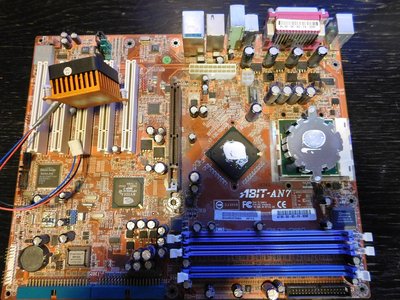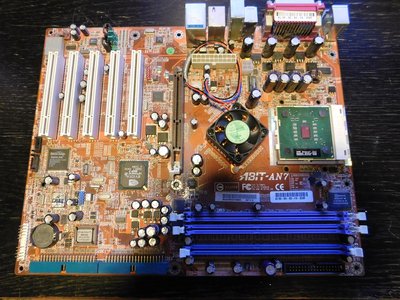I have had a buisy week but I have at least had the time to so some more testing with the Abit AN7... or more like trying to do some testing with the Abit AN7.
My now somewhat complicated relationship with the Abit AN7 started out great last weekend. I could run my Athlon XP 2800+ at 11x200 MHz with 1.5V and 12x200 with 1.7V and I could also run 10x240 with 1.7V and default chipset voltage. 240 MHz FSB seemed totally stable with all performance tweaks active including CPC but with relaxed 3-3-3-8 timings as this was with a single infineon 1GB stick. I wanted to see what the motherboard could do when running dual channel and tighter timings.
I used a couple of very capable 512MB Winbond BH5 sticks and running dual channel at 200 MHz with 2-2-2-5 timings and CPC was not an issue but anything faster than that wouldn't stay 100% stable regardless of settings. I tried alot of other memory sets with differnt types of memory chips but the stability issues only seemed to get worse. The instability first only showed at high overclocked settings or with overclocked memory runnings in Dual Channel mode but later it became an issue even at stock settings and in the end even at underclocked settings regardless of memory configuration and CPU used.
I thought that something had become corrupted so I reflashed the BIOS and reinstalled everything, nothing worked and the motherboard was now not even close to stable even at fail safe defaults. At this point I thought F**K IT and throwed the motherboard into the dishwasher without removing anything but the battery, I even left the BIOS chip in its socket. My idea was that a full program should sort out any gunk in the CPU socket, AGP slot or memory slots as the motherboard was really filthy when I got it.
After the dishwasher treatment the motherboard looked like new! I used the oven to dry the motherboard quickly, not cap friendly but I wanted it dry ASAP. After sweating for 30 min at 100C, 30 min at 75C and then 30 min at 50C I thought the motherboard was dry enough and tested it, the instability was still there. I thought about giving up at this point but something made me try to increase the CPU voltage. It turned out that the motherboard works fine as long as I use 1.85V core voltage or more...
I have tried different PSUs and I have measured every voltage including the core voltage, I can not find any reasons for the sudden instability at lower voltages. At least the issue does not seem to get any worse at this point and CPU and memory overclocking still work fine but of course only as long as I use at least 1.85V core voltage. The same 1.85V is needed to get stability at 11x166 (1833) and 11x228 (2500 MHz).
I have now read about other people with similar issues with the Abit AN7 and the solution (from what I can gather) could be to reflash some really old BIOS before again flashing one of the newer and/or tweaked BIOS versions. I have yet to try this as overclocking seems to work great at the moment and that is what I wanted the Abit AN7 for anyhow.
Some performance numbers at 2500 MHz. I'm still using the small Akasa cooler so this is as high the cooling lets me go.
Abit AN7, Athlon XP-M 2800+ @ 11x228 (2500MHz), 1x1GB DDR @228 2.5-3-3-11 CPC. Super PI 1M: 41s
Abit AN7, Athlon XP-M 2800+ @ 11x228 (2500MHz), 1x1GB DDR @228 2.5-3-3-11 CPC. 7-Zip 32M
Abit AN7, Athlon XP-M 2800+ @ 11x228 (2500MHz), 1x1GB DDR @228 2.5-3-3-11 CPC. PCMark 2002
Abit AN7, Athlon XP-M 2800+ @ 11x228 (2500MHz), 1x1GB DDR @228 2.5-3-3-11 CPC, Ti 4200 128MB. 3dmark 2000
Abit AN7, Athlon XP-M 2800+ @ 11x228 (2500MHz), 1x1GB DDR @228 2.5-3-3-11 CPC, Ti 4200 128MB. 3dmark 2001 (This is how a bottleneck looks like!)
New PC: i9 12900K @5GHz all cores @1.2v. MSI PRO Z690-A. 32GB DDR4 3600 CL14. 3070Ti.
Old PC: Dual Xeon X5690@4.6GHz, EVGA SR-2, 48GB DDR3R@2000MHz, Intel X25-M. GTX 980ti.
Older PC: K6-3+ 400@600MHz, PC-Chips M577, 256MB SDRAM, AWE64, Voodoo Banshee.











